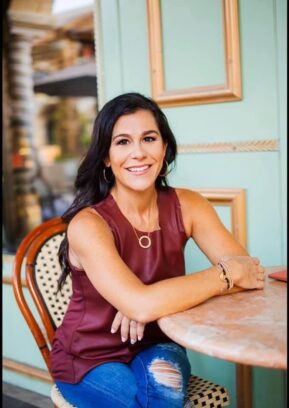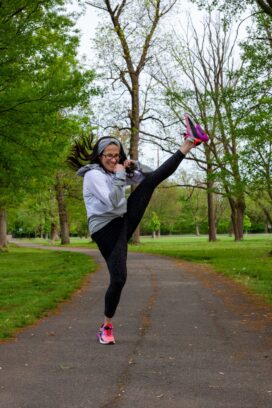Health + Medicine
Start Small, Start Now
Flour, sugar and dumbbells have, at various times, been hard to come by in the last year. Whether your shopping list contained more of one or another may indicate how you coped during the pandemic. But no matter how you got here, mazel tov on finding a recipe to help you through the disruption and heartache of these unprecedented times.

For many of us—whether we are older women who were struggling with isolation; mothers shouldering careers, households and concerns over children; or homebound college students missing their first taste of independence on campus—maintaining our health got lost in the lack of routine and mounting stress.
Now, as our worlds open up, how can we resume—and hold onto—healthy habits?
“Start small. Start now. That’s what I always say,” said Felissa Covin, an Atlanta-based health and wellness coach. If you did stop your fitness routine or gained weight, she added, “first, give yourself a break. We’re creatures of habit” who were “thrown into a situation without warning that had zero structure.”
Covin suggests setting a handful of reasonable goals. These days, her clients are interested in tips for getting more sleep—perhaps to recover from late-night binge-watching—staying active and reducing stress eating. To get there, carve out time in your calendar for incremental steps toward each goal, she said. Schedule daily physical activity or time to prepare healthy food as you would a meeting. To stick with it—and have fun—partner with a friend. And above all, “stay positive,” she said. “A negative mindset can’t make progress.”
And as you embark on physical fitness, consider this: Even if your gym or studio is still shuttered, there are myriad modes of exercise that have become available, liberating us to approach movement in new ways. Peloton devotees, avid outdoor exercisers who have sworn off the gym or fans of virtual wellness programs can all attest to that.

Kristin Traskie (left)
with a client. Photo courtesy of Courtesy of Kristin Traskie.
“Think about it as an opportunity to get really intentional about creating that new movement structure,” said Kristin Traskie, an American College of Sports Medicine personal trainer and Michigan State University fitness and wellness program coordinator from St. Johns, Mich. Ask yourself which activities you might try if you had no limitations—maybe it’s running your first 5K or the stadium steps at a local high school. If you’re stumped, Traskie suggests taking the free online “8 colors of fitness” personality quiz to help find the type of program that best suits you.
The key is making whatever fitness program you enjoy a habit, she explained: “Our bodies don’t really care if we’re moving in a gym or in a neighborhood, our backyard or our living room—they really just need that movement and that activity.” Swapping the treadmill for a walk or run in the park, she said, offers the emotional well-being of time spent in nature.
Weekly hourlong outdoor walks with close friends provide a critical physical and mental boost for Guila Franklin Siegel of Potomac, Md., associate director of the Jewish Community Relations Council of Greater Washington. While she had always enjoyed walking with friends, Siegel, 52, said the outings took on greater significance during the pandemic to combat the weight she put on from comfort baking for herself and her family. Today, she also uses walking to ease her anxiety about the post-Covid world and to indulge in the kind of mental unloading that can only take place between friends. She worries, for example, if her oldest son will be able to enjoy a non-isolated college experience in the fall and whether her younger ones will resume five days of in-person school. Even though vaccinations are becoming commonplace, she said, “you almost don’t believe it when you resume normalcy.”
Hadassah has drawn on the power of female friendships to support members with its virtual wellness programs. The latest, Every Move Counts, began on May 20 and runs through August and employs a step tracker and a social component for accountability and support. Every Move Counts also incorporates meditation and relaxation tools to help ease the anxiety of re-entering an unmasked world.
Linda Hakerem, Hadassah’s national program department chair, first started a dedicated fitness routine only a few years ago with an early iteration of Every Move Counts called Every Step Counts—and found the accessibility and social connection “addictive.” Now 74, Hakerem, of Atlanta, walks three miles almost daily. “I am the best me I have ever been,” she said.
When starting any new physical activity—particularly after a year of being sedentary—begin by learning your baseline, such as how long it takes to walk one mile, said Traskie from Michigan State. Don’t assume you have the same physical stamina you had before and don’t compare yourself to an old measurement. Ultimately, you’ll want to create a mix of aerobic activity, strength training and flexibility to boost balance and stave off injury from falls.

“Getting active is one of the healthiest decisions you can make as you age, but it’s important to do it safely,” Traskie said. Consult a doctor before beginning a new program and start with bite-sized daily goals—a 10-minute walk or five minutes of balance exercises—to slowly build stamina.
Achieving daily goals is the idea behind MindBody20, daily virtual sessions developed by Marla Rottenstreich. A marketing professional for Jewish nonprofits and a licensed personal trainer and health coach, Rottenstreich had to close her Edison, N.J., fitness studio due to Covid. She decided to create a virtual fitness program that would “repackage” the language around 2020 from a year that “really stinks” into something empowering and doable at home: a 20-day program of 20 minutes of exercise for $20. She’s since gone from coaching some 200 women in her local studio to reaching thousands both in Israel and the United States with her daily online videos. She’s recorded 450 of them to date, setting cardio, yoga and strength training routines to a range of tunes from oldies to disco and Jewish and Israeli music.

“People don’t work out during Covid, or anytime in their life, because it’s daunting,” Rottenstreich said. “My shtick is all about do what you can, celebrate your small successes.”
And forget about luring people into fitness with images of so-called perfect bodies. “You hear and you see these beautiful, super-skinny chiseled women being like, ‘Burn those calories. Get lean and trim,’ and my whole thing is always, ‘I don’t care what size you are. I’m definitely not perfect,’ ” said Rottenstreich, whose clientele ranges from elementary school age to 80.
“We don’t work out because we eat poorly,” she emphasized, but because “it’s important for our mental health. We want to press pause on the stress of the world and just have fun.”
Getting Started Again
Tips from Kristin Traskie, American College of Sports Medicine personal trainer and its 2021 Certified Fitness Professional of the Year
- Pursue a fitness program that combines aerobic activity, strength training and flexibility. Older adults should focus on stretching: overhead side stretch, back stretch and seated hip stretch held for 10 to 30 seconds; and balance, such as chair yoga (an adaptation of modern yoga that uses a chair for support and is recommended for seniors), standing on one leg or walking heal-to-toe. Consult the Physical Activity Guidelines for Americans from the United States Department of Health and Human Services for detailed guidance on exercising at different stages of life.
- Adults should strive for 150 to 300 minutes of moderate-intensity exercise or 75 to 150 minutes of vigorous-intensity exercise per week. To maintain muscle mass in the face of aging, also aim for two sessions of strength training each week to target all the major muscle groups.
- With any exercise, remember to take five to 10 minutes to warm up and cool down. “Think of that warm-up period as part of the engagement in the movement, not treating it as an option,” said Traskie.
Rachel Pomerance Berl is a freelance writer in Bethesda, Md.










 Facebook
Facebook Instagram
Instagram Twitter
Twitter
Leave a Reply